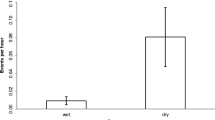Summary
Theridion pictum (Walckenaer) is a subsocial spider, that is, the mother actively takes care of her offspring for an extended period of time after they emerge. It is demonstrated that spiderling dispersal is affected by the availability of food in the maternal web. Experimental manipulations indicate that in those webs where less food was provided, spiderlings dispersed significantly earlier and in significantly greater numbers. These results illustrate the importance of food availability as a permissive factor in the evolution of social spiders from subsocial ancestors. Food availability also affects the pattern of sex-biased philopatry and dispersal. Although both sexes are more likely to remain in the maternal web when more food is available, females are relatively more likely to do so. When less food is available, females are relatively more likely to disperse than are males.
Similar content being viewed by others
References
Austad SN (1983) A game theoretical interpretation of male combat in the bowl and doily spider (Frontinella pyrimatela). Anim Behav 31:59–73
Bristowe WS (1939) The comity of spiders, vol 1. Ray Society of London, Bernard Quaritch, London
Buskirk RE (1981) Sociality in the Arachnida. In: Hermann HR (ed) Social insects. Academic Press, New York, pp 282–359
Emlen ST, Oring LW (1977) Ecology, sexual selection and the evolution of mating systems. Science 197:215–233
Evans HE (1958) The evolution of social life in wasps. Proc 10th Int Congr Entomol 2:449–457
Gillespie RG (1987) The role of prey availability in aggregating behaviour of the orb weaving spider Tetragnatha elongata. Anim Behav 35:675–681
Greenwood PJ (1980) Mating systems, philopatry and dispersal in birds and mammals. Anim Behav 28:1140–1162
Howard RD (1988) Reproductive success in two species of anurans. In: Clutton-Brock TH (ed) Reproductive success; studies of individual variation in contrasting breeding systems. University of Chicago Press, Chicago London, pp 99–113
Kaston BJ (1953) How to know the spiders, 3rd edn. The pictured key nature series. Brown, Dubuque, IA
Krafft B, Horel A, Julita J-M (1986) Influence of food supply on the duration of the gregarious phase of a maternal-social spider, Coelotes terrestris (Araneae, Agelenidae). J Arachnol 14:219–226
Krebs JR, Davies NB (1984) Behavioural ecology; an evolutionary approach, 2nd edn. Blackwell Scientific Publications, Oxford
Kullmann EJ (1972) Evolution of social behavior in spiders (Araneae; Eresidae and Theridiidae). Am Zool 12:419–426
Levi HW (1957) The spider genera Enoplognatha, Theridion, and Paidisca in America north of Mexico. Bull Am Mus Nat Hist 112:1–124
Michener DD (1958) The evolution of social behavior in bees. Proc 10th Int Congr Entomol 2:441–447
Nentwig W (1985) Social spiders catch larger prey: a study of Anelosimus eximius (Araneae: Theridiidae). Behav Ecol Sociobiol 17:79–85
Packer C, Ruttan LM (1988) The evolution of cooperative hunting. Am Nat 132:159–198
Rubenstein DI, Wrangham RW (1986) Ecological aspects of social evolution. Birds and mammals. Princeton University Press, Princeton
Ruttan LM (1988) The ecology of subsociality in Theridion pictum (Walckenaer) (Araneae: Theridiidae). M S thesis, University of Minnesota
Rypstra AL (1986) High prey abundance and a reduction in cannibalism: the first step to sociality in spiders (Arachnida). J Arachnol 14:193–200
Rypstra AL (1989) Foraging success of solitary and aggregated spiders: insights into flock formation. Anim Behav 37:274–281
Shear WA (1970) The evolution of social phenomena in spiders. Bull Brit Arachnol Soc 1:65–76
Smith DRR (1983) Ecological costs and benefits of communal behavior in a presocial spider. Behav Ecol Sociobiol 13:107–114
Vollrath F (1986) Eusociality and extraordinary sex-ratios in the spider Anelosimus eximius (Araneae: Theridiidae). Behav Ecol Sociobiol 18:283–287
Wilson EO (1971) The insect societies. Belknap Press, Boston
Author information
Authors and Affiliations
Rights and permissions
About this article
Cite this article
Ruttan, L.M. Experimental manipulations of dispersal in the subsocial spider, Theridion pictum . Behav Ecol Sociobiol 27, 169–173 (1990). https://doi.org/10.1007/BF00180300
Issue Date:
DOI: https://doi.org/10.1007/BF00180300




